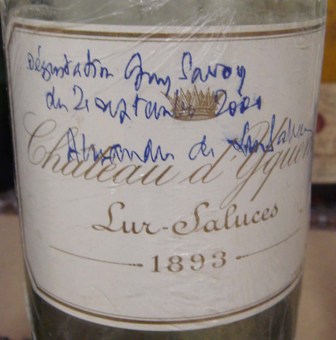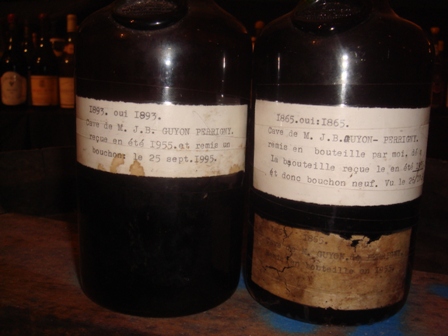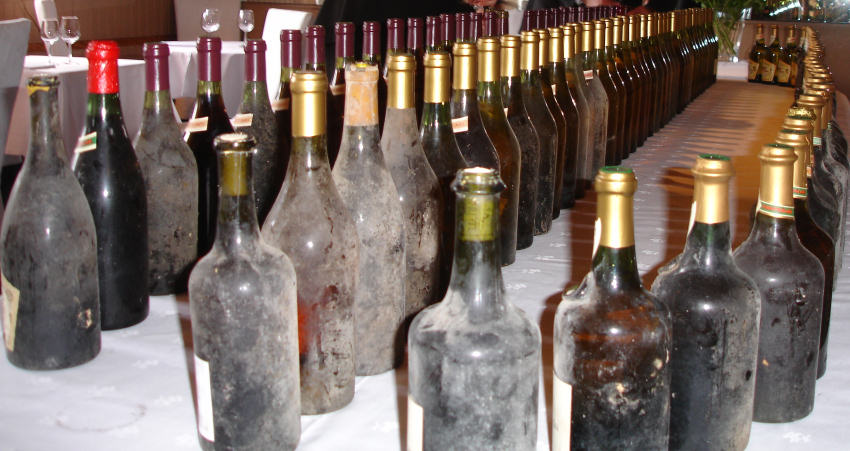Cela faisait longtemps qu’on le bichonnait ce dîner avec Jacques Le Divellec. Des essais de plats, des mises au point, autant de prétexte pour se retrouver et parler de gastronomie. Lorsque j’arrive pour ouvrir les bouteilles, je sens l’équipe totalement motivée. Olivier, sommelier attentif, se réjouit de servir des flacons rares. Jacques Le Divellec est comme un jeune étudiant qui attend de passer un concours. C’est en effet un événement de création et d’amitié qui se prépare.
L’ouverture des bouteilles se passe sans aucune difficulté, comme par routine, mais j’ai une très grande surprise. J’avais annoncé Château Latour 1934 reconditionné en 2001. Or en enlevant la capsule, le bouchon est tout noir. Et en piquant le tirebouchon, je constate que le bouchon se brise en mille morceaux. Il s’agit manifestement du bouchon d’origine. Je lis l’étiquette, et je m’aperçois que j’avais fait un contresens. L’étiquette du château annonce bien Latour 1934 mais indique : « cette bouteille a été rhabillée au château en 2001 sous le numéro … ». Ce qui semble indiquer que l’on n’a touché à rien, ni au liquide de beau niveau ni au bouchon. On a seulement changé l’étiquette et la capsule. J’ai commis une erreur en lisant trop rapidement. Et c’est tant mieux, car une bouteille au bouchon d’origine a toujours un goût plus authentique qu’une bouteille rebouchée.
Mes convives sont cinq couples de jeunes et entreprenants résidents suisses dont les origines couvrent toute l’Europe. Les cinq femmes sont ravissantes et je m’en plains. Car concentrer sur un seul dîner autant de beautés merveilleuses est de la gourmandise. Ils arrivent tous ensemble et comme il fait beau, c’est sous les arbres de l’esplanade des Invalides que je donne les consignes habituelles, les femmes frémissant en silence sous la fraîche bise du soir.
Nous passons à table et pouvons lire sur un parchemin le menu créé par Jacques Le Divellec : Pieds de cheval de pleine mer / Carpaccio de turbot du pays breton / Bouquet printanier à la fricassée de casserons et coquillages / Grosses langoustines, au foie gras de canard poele / Mammifère rôti, échalotes confites, ail en chemise / Bar sur peau sauce lie de vin à la grenaille de Noirmoutier / Cassolette de homard à la nage de truffes / Bécasse rôtie sur canapé, purée de ratte / Comté affiné / Stilton / Composition fruitière d’agrumes. Jacques Le Divellec a brillamment simplifié les recettes, épuré les présentations, s’appliquant au goût pur de produits beaux et rares. Ce fut brillant.
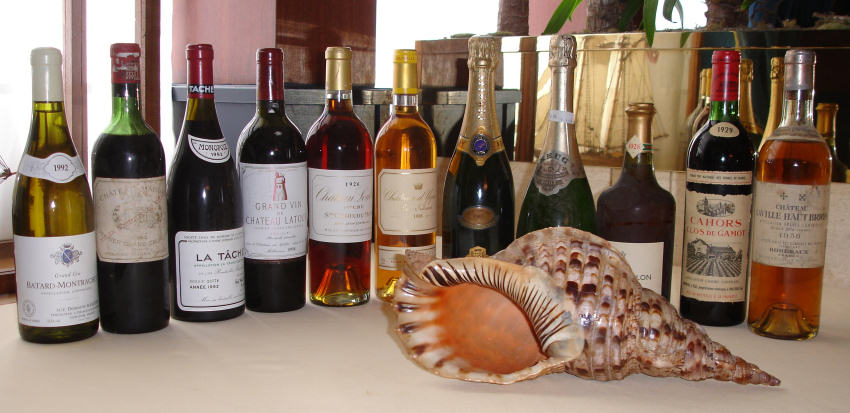 Le Champagne Pommery 1987 ne me déçoit jamais. Facile à comprendre, frais, champagne de soif au beau message, il accompagne divinement de lourdes huîtres plates au parfum prononcé. Pour de si belles frêles bouches, il eut fallu des pieds de poulain plutôt que de cheval. L’association fut parfaite dans sa simplicité. Ce qui était spectaculaire, c’est que le goût du champagne faisait un prolongement, sans aucune rupture, avec la belle salinité des huîtres.
Le Champagne Pommery 1987 ne me déçoit jamais. Facile à comprendre, frais, champagne de soif au beau message, il accompagne divinement de lourdes huîtres plates au parfum prononcé. Pour de si belles frêles bouches, il eut fallu des pieds de poulain plutôt que de cheval. L’association fut parfaite dans sa simplicité. Ce qui était spectaculaire, c’est que le goût du champagne faisait un prolongement, sans aucune rupture, avec la belle salinité des huîtres.
Le Champagne Krug Clos du Mesnil 1982 est seigneurial. Quelle profondeur de trame. Le Pommery était évidemment destiné à le mettre en valeur, pour qu’on constate sa richesse et sa perfection. Le turbot est la chair la plus élégante des chairs crues, car on profite de la personnalité du poisson sans subir la signature typée du carpaccio. La trace en bouche de ce merveilleux champagne est indélébile, marquée de fruits rouges confits, de fumé, de fleurs odorantes.
Les casserons sont de petites seiches à la chair délicate. Le Laville Haut-Brion blanc 1958 a pris une couleur dorée, son nez est magistral, et en bouche son élégance se découvre progressivement. Il s’épanouit, s’élargit, et c’est surtout avec les bulots que l’accord est intense. Beau vin de Bordeaux qui est nettement moins long que le Laville 1955 éblouissant, bu avec mon ami californien.
Le Bâtard Montrachet Domaine Ramonet 1992 est infiniment plus facile à comprendre, car le Laville fait « vin ancien », quand le Ramonet fait fringant jeune homme en pleine force de l’âge. Quelle puissance ! Un mariage à trois va se former, qui permet de constater que l’on peut passer de la langoustine au foie gras et inversement avec une facilité et un confort gustatif étonnants. Même si le Bâtard est éblouissant de générosité, il ne peut pas voler la vedette à la magistrale langoustine dont la chair est gourmande, joyeuse.
Le mammifère marin – pensez à Moby Dick – a une chair intense, prononcée. Et c’est manifestement de la viande, pas de la chair de poisson. Avec lui, le Château Margaux 1962 va se montrer éblouissant. Velouté, doucereux, presque sucré tant il joue la douceur, il décline aussi des subtilités rares. Un vin de forte séduction. Comme par un mimétisme, le Château Latour 1934 rhabillé en 2001 va jouer sur le même registre avec le bar dont le goût fort sera particulièrement apprécié de ma jeune tablée. Un peu plus dense que le Margaux, on serait bien en peine de déclarer lequel des deux est le plus jeune, alors que 28 ans les séparent ! Belle longueur, densité, le vin de 1928, épanoui, n’a pas d’âge, étant naturellement brillant. Comme son année le laisse imaginer, le 1962 ne brille pas par sa force, préférant le registre serein et structuré.
C’est le Cahors Clos de Gamot (Jouffreau) 1929 qui va voler la vedette aux Bordeaux rouges. Quel grand vin ! Sa couleur est d’une jeunesse surprenante, d’un grenat rayonnant, son nez est agréable, mais c’est surtout en bouche que sa clarté s’affirme. Il ne joue pas sur la puissance, il est léger, aérien, mais ses 77 ans l’ont équilibré, épanoui au-delà du prévisible. Et le goût puissant du homard, amplifié par la truffe était exactement ce qu’il fallait pour que le vin brille plus encore.
On va finir par me suspecter de parti pris. Car La Tâche Domaine de la Romanée Conti 1992 est pour moi, mais aussi pour mes convives, absolument éblouissant. Je goûte pour la première fois ce minuscule volatile que prisait François Mitterand, que certaines de mes ravissantes voisines mangeront avec de jolies grimaces, mais plus de courage que certains de leurs chevaliers servants. La bécasse goûteuse parle bien à La Tâche dont la profondeur de goût, la variété sur tons d’automne, sont éblouissantes. Plus que d’autres, je vibre aux accents raffinés des vins sublimes de ce domaine.
Avec un Comté élégamment discret pour ne pas biaiser l’expérience, le Château Chalon Jean Bourdy 1928 généreux, chantant, va ravir toute notre table de ses accents joyeux. Que cela parait naturel. Je l’avais rajouté au programme, pour le plaisir. J’ai bien fait.
Le Château Loubens Sainte Croix du Mont 1926 a époustouflé toute la table. Comme pour le dîner chez Gérard Besson où j’avais inclus Loubens 1943, personne n’attendrait un Sainte Croix du Mont à ce niveau de perfection et d’intensité. Les fruits exotiques, le thé forment avec élégance un goût profond et envoûtant. Une réussite rare, qui place le Château d’Yquem 1988 en situation de challenger. Malgré ses qualités, sa jeunesse parait facile à côté de la complexité du Loubens. Le dessert fort intelligemment simplifié convient à l’Yquem.
Malgré les rires et les propos débridés d’amis heureux d’être ensemble, il fallait voter. Huit vins sur les onze ont reçu au moins un vote, et cinq vins recueillirent un vote de numéro un, ce qui me plait beaucoup. Le Château Loubens 1926 a obtenu trois votes de premier, comme le Château Chalon 1928. Le Château Latour 1934 a recueilli deux voix de premier, et le Krug 1982 et La Tâche 1992 ont eu chacun un vote de premier. Le vote du consensus serait Loubens 1926 (deux Loubens de suite en première place dans deux dîners, c’est rare), Château Chalon 1928, Château Latour 193 et La Tâche 1992. Mon vote : 1- La Tâche DRC 1992, 2- Cahors Clos de Gamot 1929, 3- Loubens 1926, 4- Château Chalon Bourdy 1928.
Au niveau des goûts, je ne fis pas voter. J’ai surtout noté la chair de la grosse langoustine, et la tendreté des casserons. L’accord le plus beau fut celui du homard avec le Cahors 1929. Mais le bulot avec le Laville 1958, c’est aussi très beau.
Que retenir de ce dîner. D’abord l’extrême générosité de Jacques Le Divellec qui nous a fait goûter des fruits défendus. Ensuite, son engagement, son enthousiasme d’enfant, lui qui a connu tant d’occasions de faire des dîners de rêve. Le challenge lui plaisait, il l’a pris et il l’a réussi. L’équipe motivée, attentive, consciente de l’événement qui se créait. Les vins qui brillent naturellement, facilement, sans qu’on ait besoin de se poser la moindre question sur leur état de forme. Ce 72ème dîner de wine-dinners souriant fut une grande réussite. Kiri, Hubert, Delphine, Marc-Antonio, Monica, Aymar, Isabelle, Stanislas, Jean-Christophe et Tatiana se sont forgé des souvenirs pour une vie.
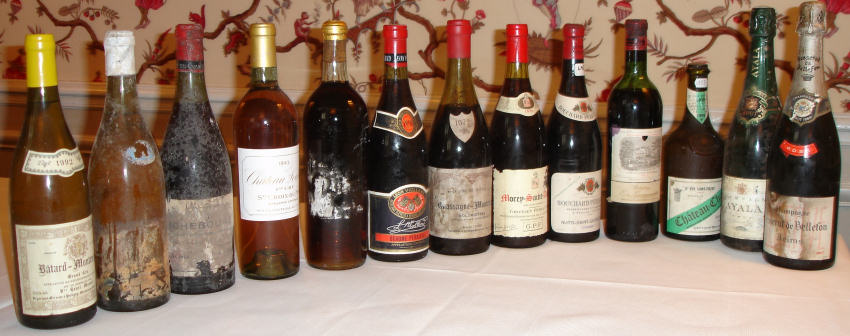
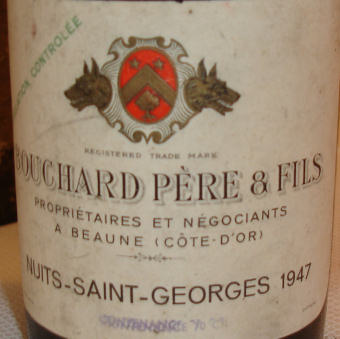 Le
Le 